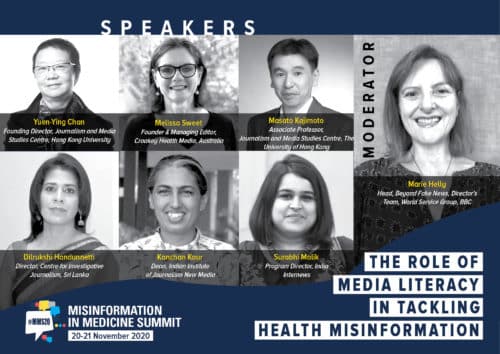A thought-provoking session on media literacy at the Misinformation in Medicine Summit stressed on the need to have a holistic approach to combat the challenges involved in improving media literacy.
The third edition of Medical Misinformation Summit 2020, held online on November 20 and 21 featured a panel discussion on media literacy – how to make the end consumers media-literate so that they do not become a connecting node in the spread of viral misinformation.
The members of the panel acknowledged that it is important to bring all the stakeholders on the same page to restrict or rather curb the spread of misinformation. Moderated by Marie Helly, Head of BBC’s Beyond Fake News, the session emphasised on the importance of ensuring that people have the media literacy not only to engage with the media but to engage with society through the media.
Masato Kajimoto, Associate Professor at the Journalism and Media Studies Centre at the University of Hong Kong said that media literacy is “not a magic wand” and that it involves both long-term as well as short-term strategies.
“I think health experts and journalists need to go through formal training in how the misinformation ecosystem works. Who is producing what kind of content, why this particular content goes viral, and how the code, the algorithm works, I think that kind of knowledge is necessary to tackle the misinformation,” said Masato.
Melissa Sweet, Founding and Managing Editor at Croakey Health Media added, “One of the biggest challenges to curb misinformation is that there’s no definitive guide on how to recognize misinformation because it comes cloaked as genuine information.”
COVID-19 presents new problems and challenges for journalists. Yet there seems to be neither an understanding of the situation nor an agreement about how to respond to it. This is true at both domestic and international levels.
Dilrukshi Handunetti, Lawyer and Director for Centre for Investigative Reporting, Sri Lanka while sharing her views added, “ I think journalists have a pioneering role to play in managing disinformation and therefore, they should be able to distinguish it from falsehood and place it in the public domain with a sense of responsibility.”
Agreed Surabhi Mallik, Program Director at Internews India. Malik runs a Media Literacy Initiative, called FactShala in partnership with DataLEADS. She emphasised that different subsets that are a part of the information ecosystem should be brought together. “From scientists and doctors to journalists and the end audience, we need to look at how we join and connect them and convey the correct information forward.”
But Kanchan Kaur, Professor of Journalism and Dean at the Indian Institute of Journalism and New Media, Bangalore had a different opinion altogether. According to Kaur, doctors play a vital role in curbing the spread of medical misinformation.
She said, “Doctors are like priests; they are the ones who are trusted by the masses. And that is why it is important that we have doctors out there, on social media, on all forums talking about what is really happening and debunking the myths around the whole pandemic. It is really important that the doctors come out and talk about it.”
Ying Chang, Founding Director of the University of Media Studies at the University of Hong Kong suggested that the need of the hour is to have a holistic approach. She said, “For media literacy, we need to think beyond journalists, media professionals, or educators. We need to explore the role of the whole society.”
In their final comment, Kajimoto batted for making media literacy as part of teachers’ certification program, whereas Chang stressed on building collaborations across disciplines, countries, and borders.
While Kaur stressed the need to be proactive, Mallik in her concluding remark warned that consumers of online information tend to catch the wrong signals, and that leads them astray.
The overriding emphasis of the discussion was that it’s important to bring together the owners of medical misinformation – doctors and scientists – and the disseminators – journalists together on the same page, so that the information that goes out is credible, authentic, and reliable.
You can watch the recording of the session here.


















Add Comment